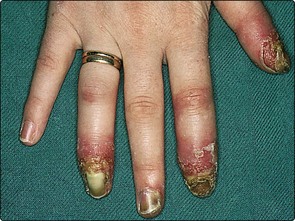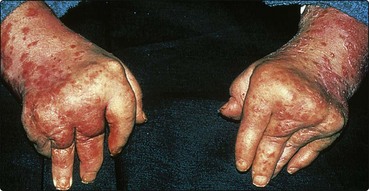Psoriasis – Management and complications
Management
The non-infectious nature of psoriasis, its relapsing nature and the likely need for long-term therapy should be explained. A sympathetic approach is helpful, and patients often obtain support from the self-help group The Psoriasis Association (see p. 132). Treatment is tailored to the patient’s particular requirements, taking into account the type and extent of the disease, and the age and social background (Table 1).
Table 1 A guide to psoriasis therapy
| Type of psoriasis | Treatment options |
|---|---|
| Stable plaque | Vitamin D analogue with topical steroid Dithranol (short contact), coal tar, tazarotene Narrow-band ultraviolet B |
| Extensive plaque | Narrow-band ultraviolet B (plus topicals) Methotrexate, ciclosporin, PUVA or Re-PUVA Biologics |
| Guttate | Topical steroids (mild/moderate), coal tar Narrow-band ultraviolet B |
| Facial/flexural | Topical steroids (mild/moderate); tacalcitol |
| Palmoplantar | Topical steroids (potent) Acitretin, PUVA or Re-PUVA |
| Generalized pustular; erythrodermic | Acitretin, methotrexate, ciclosporin Biologics |
Topical therapy
It is usual to prescribe topical agents as the first-line treatment.
Vitamin D analogues
Calcipotriol (Dovonex), tacalcitol (Curatoderm) and calcitriol (Silkis) are topical synthetic vitamin D analogues for use in mild and moderate chronic plaque psoriasis. They inhibit cell proliferation and stimulate keratinocyte differentiation, correcting some of the epidermal cell proliferation changes in psoriasis. Patient acceptability is good as the preparations do not smell or stain, are easy to apply and do not have the risk of skin atrophy seen with topical steroids. Skin irritation may be a problem. Efficacy is commensurate with dithranol or topical steroids.
Hypercalcaemia is possible if the maximum dose is exceeded. Calcipotriol cream can be used up to 100 g/week (40% of the body surface on a twice-daily basis), and tacalcitol ointment up to 35 g/week (20% of body surface as a once-daily dose). Tacalcitol is tolerated on the scalp and face, where calcipotriol tends to irritate. Calcipotriol is available as a scalp preparation. Vitamin D analogues are often used in alternation with a topical steroid, and in combination with ultraviolet B or psoralen plus ultraviolet A (PUVA) therapy.
Topical corticosteroids
Topical steroids have the advantage of being clean, non-irritant and easy to use. However, against this must be balanced the risk of side-effects (p. 23) and of precipitating an unstable form of psoriasis, especially on their withdrawal. Topical steroids are the treatment of choice for face, genitalia and flexures, and are useful for stubborn plaques on hands, feet and scalp. Potent steroids should not be applied to the face, although they may be used judiciously on palms and soles. Elsewhere, moderately potent steroids normally suffice. Their use must be monitored carefully. Creams are often preferred to ointments. Lotions and gels are available for the scalp.
Coal tar preparations
Coal tar distillates have been used for decades to treat psoriasis. They are safe and seem to act by inhibiting DNA synthesis. The main disadvantages of tar are that it smells and is messy. Despite this, it can be useful for inpatient care, e.g. combined with ultraviolet B – the Goeckermann regimen. Refined tar (1–10%) is available in a cream or lotion base for outpatient use (e.g. Carbo-Dome, Exorex, Psoriderm). These preparations are suitable for chronic plaque psoriasis or guttate psoriasis once the acute phase is past.
Dithranol (anthralin)
Dithranol has an antimitotic effect and is irritant to normal skin. It cannot be used on the face or genitalia, and it stains skin, hair, linen, clothes and bathtubs a purple-brown colour. For inpatient use, the usual base is Lassar’s paste (zinc and salicylic acid paste BP). It is applied to the plaques of psoriasis initially in the 0.1% strength, increasing up to 2% if necessary. The surrounding skin is protected with a bland preparation such as white soft paraffin, and the treated area is covered with tube gauze. The combination of this with a daily tar bath and ultraviolet B is called the Ingram regimen. Psoriasis clears within 3 weeks in most patients on this treatment.
The ‘short contact regimen’, in which dithranol is applied for 30 min each day, is suitable for outpatients with stable plaque psoriasis. The dithranol is best washed off in a shower. Dithrocream is a suitable preparation and comes in concentrations from 0.1% to 2%.
Retinoids
A topical retinoid, tazarotene (0.05% and 0.1%; Zorac gel), is effective for chronic plaque psoriasis. It may irritate and is often used alternating with a topical steroid.
Keratolytics and scalp preparations
Hyperkeratotic psoriasis of the palms and soles can be treated with 5% salicylic acid ointment. Scalp psoriasis (Fig. 1) responds to 3% salicylic acid in a cream base (sometimes with 3% precipitated sulphur) applied daily or every 2 or 3 days, and is used in combination with a tar-containing shampoo (e.g. Alphosyl 2 in 1, Capasal, Polytar, T/Gel). Coconut oil compound (e.g. Cocois, with tar, salicylic acid and sulphur) also helps scaly scalps.
Systemic therapy
Psoriasis that is life-threatening, unresponsive to adequate topical treatment or restricting the ability to work (Fig. 2) may require systemic therapy. Benefits must be weighed against side-effects. The use of potentially toxic drugs is justified by their ability to transform a patient’s life from severely restricted to nearly normal. Phototherapy and photochemotherapy are outlined on page 106.

Fig. 2 Acrodermatitis continua variant of psoriasis.
Sterile pustular changes with dactylitis are present on three fingers.
Methotrexate
The folate antagonist methotrexate is well established as an effective treatment for severe psoriasis and may have anti-inflammatory as well as immune modulatory effects. It is given once a week orally as a single dose (usually 7.5–15 mg), although it can be given subcutaneously or intramuscularly. Normal liver, kidney and bone marrow function must be established before starting methotrexate, and these functions must be monitored during treatment. Liver disease, alcoholism and acute infection are contraindications to methotrexate, and drug interaction (e.g. with aspirin, non-steroidal anti-inflammatory drugs or co-trimoxazole) must be avoided. Improvement is seen within 2–4 weeks. Minor side-effects (e.g. nausea) are common, but liver fibrosis or cirrhosis is a risk long term. Liver damage can be monitored using the serum procollagen III aminopropeptide. Most authorities now regard the morbidity and cost of routine liver biopsy to be unjustified. Methotrexate is also a teratogen.
Retinoids
The vitamin A derivative acitretin (Neotigason) is particularly effective in treating pustular psoriasis and in thinning hyperkeratotic plaques. Acitretin may be used with topical therapies or with UVB or PUVA (‘Re-PUVA’), when it allows a more rapid clearance at a lower total dose of UV. Most patients develop minor side-effects, such as dry mucous membranes, itching and peeling skin. More serious complications include hyperostosis, abnormal liver function, hyperlipidaemia and teratogenicity. The last virtually precludes the use of acitretin in women of child-bearing age. Although acitretin has a half-life of 50 days, in some patients it is metabolized to etretinate, a retinoid that takes 2 years to be excreted.
Ciclosporin
Ciclosporin, an immunosuppressant widely used to prevent rejection of organ transplants, is effective in severe psoriasis. It acts by inhibiting T lymphocyte activation and interleukin-2 production. Dose-dependent reversible nephrotoxicity is a side-effect. Blood pressure and kidney function are monitored during treatment. There may be a risk of skin cancer or lymphoma, and concomitant UV treatment is avoided.
Biologic agents and other systemic treatments
Other immunosuppressive drugs can control psoriasis, but they are not as potent as methotrexate. Hydroxycarbamide has the advantage of not affecting the liver, but it can suppress the bone marrow. Fumaric acid esters are effective in some cases (p. 114). Biologic agents are very effective but expensive (see p. 114).
Complications
Psoriasis may be complicated by arthropathy, erythroderma and the Koebner phenomenon (p. 28, Fig. 2). It is associated with the metabolic syndrome and an increased risk of cardiovascular disease.
Psoriatic arthropathy
Psoriatic joint disease occurs in 20–30% of patients with psoriasis and is associated with more severe skin disease. It shows an equal sex ratio and takes three forms:
1. Asymmetrical arthritis. A small number of joints are usually involved, with few erosions and good preservation of function.
2. Symmetrical polyarthritis. This form is associated with erosions, deformity and loss of function (Fig. 3). It is distinguished from rheumatoid arthritis by predominantly affecting distal interphalangeal joints and by the rheumatoid factor test being negative.
3. Predominant spondylitis. This type is similar to ankylosing spondylitis and may be accompanied by a peripheral arthritis, although it behaves independently of it.
Erythrodermic psoriasis
Inpatient treatment is needed for this condition, often with systemic drugs. Details are given on page 44.
Treatment of psoriasis
Side-effects are often the limiting factor in psoriasis treatment.
Topical treatment is usually the first approach:
 Steroids: popular and effective but beware of side-effects.
Steroids: popular and effective but beware of side-effects.
 Vitamin D analogues: clean and effective but may irritate.
Vitamin D analogues: clean and effective but may irritate.
 Coal tar: safe but messy and not very popular with patients.
Coal tar: safe but messy and not very popular with patients.
 Dithranol: effective, irritant, rather impractical for home use.
Dithranol: effective, irritant, rather impractical for home use.
 Keratolytics: useful for scalp disease combined with tar or sulphur.
Keratolytics: useful for scalp disease combined with tar or sulphur.

